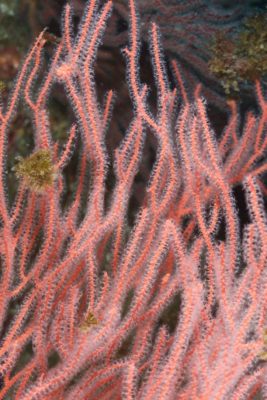
Corals are not rocks, nor plants. They are animals. Invertebrates, specifically. These sessile organisms are colonial—meaning many individual organisms comprise a single coral. These individual organisms are called polyps. Each polyp is complete with a mouth, a stomach, and multi-purpose tentacles. More on that later.
There are two major types of coral: soft corals and stony corals. The stony corals are considered reef builders, oceanic architects. The polyps that create stony corals secrete a hard skeletal structure made of calcium carbonate. Soft corals, on the other hand, have a different kind of support structure. Their polyps contain something called sclerites—a hard plate of chitin, which is what the exoskeletons of arthropods (think crabs and lobsters) are made of. Recent underwater explorations have discovered a third type of coral: deep sea coral. 20,000 below the surface of the ocean thrive both stony and soft corals. They differ from the shallow water corals in one major respect—they don’t need sunlight to survive.
That Big Ball of Energy
Photosynthesis. The process of converting the sun’s light energy into chemical energy. Many corals have the ability to do this. But polyps cannot complete the task on their own. To create their food source, their energy for survival, they obtain help from zooxanthellae. Put simply, zooxanthellae are microscopic algae. These algae find their home in the surface tissue of coral polyps. In return for shelter, these algae give coral the energy they need to survive. Additionally, these zooxanthellae provide a plethora of colors and patterns for corals. That rainbow of life that paints the iconic coral reefs of the world is much in thanks to zooxanthellae. The relationship between the polyp and zooxanthellae is symbiotic and mutually beneficial. Each one needs the other for its survival. When conditions in the ocean become inhabitable (think: too warm, too acidic), zooxanthellae are kicked out. The polyps, in times of stress, will expel their zooxanthellae—leaving the coral stark white and starving. This is called a coral bleaching event.
The Corals of Catalina Island
Most corals are found in warm tropical waters, near the equator, where there is clear water and ample light for photosynthesis to occur. Catalina lies in a temperate, nutrient rich zone of the ocean—not ideal for a coral reef. Nevertheless, among rocky reefs of Catalina exist a handful of coral. Purple Hydrocoral. Sea Pens. Cup Coral. Gorgonians. Although they are not reef-building corals, they fill their own ecological niche in their home waters.
Sources:
http://ocean.si.edu/deep-sea-corals
https://oceanservice.noaa.gov/education/kits/corals/coral02_zooxanthellae.html
https://oceanservice.noaa.gov/education/tutorial_corals/coral01_intro.html


